
Nikita Khrushchev orders withdrawal of missiles from Cuba on October 28, 1962
Nikita Khrushchev orders withdrawal of missiles from Cuba: Soviet Premier Nikita Khrushchev orders withdrawal of missiles from Cuba, ending the Cuban Missile Crisis.
In 1960, Khrushchev had launched plans to install medium and intermediate range ballistic missiles in Cuba that would put the eastern United States within range of nuclear attack. In the summer of 1962, U.S. spy planes flying over Cuba had photographed construction work on missile facilities.

The Cuban Missile Crisis of October 1962 was a direct and dangerous confrontation between the United States and the Soviet Union during the Cold War and was the moment when the two superpowers came closest to nuclear conflict. The crisis was unique in a number of ways, featuring calculations and miscalculations as well as direct and secret communications and miscommunications between the two sides. The dramatic crisis was also characterized by the fact that it was primarily played out at the White House and the Kremlin level with relatively little input from the respective bureaucracies typically involved in the foreign policy process.
After the failed U.S. attempt to overthrow the Castro regime in Cuba with the Bay of Pigs invasion, and while the Kennedy administration planned Operation Mongoose, in July 1962 Soviet premier Nikita Khrushchev reached a secret agreement with Cuban premier Fidel Castro to place Soviet nuclear missiles in Cuba to deter any future invasion attempt. Construction of several missile sites began in the late summer, but U.S. intelligence discovered evidence of a general Soviet arms build-up on Cuba, including Soviet IL–28 bombers, during routine surveillance flights, and on September 4, 1962, President Kennedy issued a public warning against the introduction of offensive weapons into Cuba. Despite the warning, on October 14 a U.S. U–2 aircraft took several pictures clearly showing sites for medium-range and intermediate-range ballistic nuclear missiles (MRBMs and IRBMs) under construction in Cuba. These images were processed and presented to the White House the next day, thus precipitating the onset of the Cuban Missile Crisis.
Kennedy summoned his closest advisers to consider options and direct a course of action for the United States that would resolve the crisis. Some advisers—including all the Joint Chiefs of Staff—argued for an air strike to destroy the missiles, followed by a U.S. invasion of Cuba; others favored stern warnings to Cuba and the Soviet Union. The President decided upon a middle course. On October 22, he ordered a naval “quarantine” of Cuba. The use of “quarantine” legally distinguished this action from a blockade, which assumed a state of war existed; the use of “quarantine” instead of “blockade” also enabled the United States to receive the support of the Organization of American States.
That same day, Kennedy sent a letter to Khrushchev declaring that the United States would not permit offensive weapons to be delivered to Cuba, and demanded that the Soviets dismantle the missile bases already under construction or completed, and return all offensive weapons to the U.S.S.R. The letter was the first in a series of direct and indirect communications between the White House and the Kremlin throughout the remainder of the crisis.
The President also went on national television that evening to inform the public of the developments in Cuba, his decision to initiate and enforce a “quarantine”, and the potential global consequences if the crisis continued to escalate. The tone of the President’s remarks was stern, and the message unmistakable and evocative of the Monroe Doctrine: “It shall be the policy of this nation to regard any nuclear missile launched from Cuba against any nation in the Western Hemisphere as an attack by the Soviet Union on the United States, requiring a full retaliatory response upon the Soviet Union.” The Joint Chiefs of Staff announced a military readiness status of DEFCON 3 as U.S. naval forces began implementation of the quarantine and plans accelerated for a military strike on Cuba.

On October 24, Khrushchev responded to Kennedy’s message with a statement that the U.S. “blockade” was an “act of aggression” and that Soviet ships bound for Cuba would be ordered to proceed. Nevertheless, during October 24 and 25, some ships turned back from the quarantine line; others were stopped by U.S. naval forces, but they contained no offensive weapons and so were allowed to proceed. Meanwhile, U.S. reconnaissance flights over Cuba indicated the Soviet missile sites were nearing operational readiness. With no apparent end to the crisis in sight, U.S. forces were placed at DEFCON 2—meaning war involving the Strategic Air Command was imminent. On October 26, Kennedy told his advisors it appeared that only a U.S. attack on Cuba would remove the missiles, but he insisted on giving the diplomatic channel a little more time. The crisis had reached a virtual stalemate.
That afternoon, however, the crisis took a dramatic turn. ABC News correspondent John Scali reported to the White House that he had been approached by a Soviet agent suggesting that an agreement could be reached in which the Soviets would remove their missiles from Cuba if the United States promised not to invade the island. While White House staff scrambled to assess the validity of this “back channel” offer, Khrushchev sent Kennedy a message the evening of October 26, which meant it was sent in the middle of the night Moscow time. It was a long, emotional message that raised the specter of nuclear holocaust, and presented a proposed resolution that remarkably resembled what Scali reported earlier that day.
“If there is no intention”, he said, “to doom the world to the catastrophe of thermonuclear war, then let us not only relax the forces pulling on the ends of the rope, let us take measures to untie that knot. We are ready for this.”
Although U.S. experts were convinced the message from Khrushchev was authentic, hope for a resolution was short-lived. The next day, October 27, Khrushchev sent another message indicating that any proposed deal must include the removal of U.S. Jupiter missiles from Turkey. That same day a U.S. U–2 reconnaissance jet was shot down over Cuba. Kennedy and his advisors prepared for an attack on Cuba within days as they searched for any remaining diplomatic resolution. It was determined that Kennedy would ignore the second Khrushchev message and respond to the first one. That night, Kennedy set forth in his message to the Soviet leader proposed steps for the removal of Soviet missiles from Cuba under supervision of the United Nations, and a guarantee that the United States would not attack Cuba.
It was a risky move to ignore the second Khrushchev message. Attorney General Robert Kennedy then met secretly with Soviet Ambassador to the United States, Anatoly Dobrynin, and indicated that the United States was planning to remove the Jupiter missiles from Turkey anyway, and that it would do so soon, but this could not be part of any public resolution of the missile crisis. The next morning, October 28, Khrushchev issued a public statement that Soviet missiles would be dismantled and removed from Cuba.
The crisis was over but the naval quarantine continued until the Soviets agreed to remove their IL–28 bombers from Cuba and, on November 20, 1962, the United States ended its quarantine. U.S. Jupiter missiles were removed from Turkey in April 1963.

The Cuban missile crisis stands as a singular event during the Cold War and strengthened Kennedy’s image domestically and internationally. It also may have helped mitigate negative world opinion regarding the failed Bay of Pigs invasion. Two other important results of the crisis came in unique forms.
First, despite the flurry of direct and indirect communications between the White House and the Kremlin - perhaps because of it - Kennedy and Khrushchev, and their advisers, struggled throughout the crisis to clearly understand each others’ true intentions, while the world hung on the brink of possible nuclear war. In an effort to prevent this from happening again, a direct telephone link between the White House and the Kremlin was established; it became known as the “Hotline”.
Second, having approached the brink of nuclear conflict, both superpowers began to reconsider the nuclear arms race and took the first steps in agreeing to a nuclear Test Ban Treaty.
History Channel / Wikipedia / Office of the Historian.gov / U.S. Department of State.gov /
John F. Kennedy Presidential Library and Museum.org / Foreign Policy / Cuban Missile Crisis.org /
Nikita Khrushchev orders withdrawal of missiles from Cuba on October 28, 1962 (YouTube) 

This Day in History October 28
• 312 Battle of the Milvian Bridge: Constantine I defeats Maxentius, becoming the sole Roman emperor in the West.
• 969 Siege of Antioch (968–969): The Byzantine Empire recovers Antioch from Arab rule.
• 1420 Beijing is officially designated the capital of the Ming dynasty when the Forbidden City is completed.
• 1492 Christopher Columbus lands in Cuba on his first voyage to the New World.
• 1628 French Wars of Religion: Siege of La Rochelle: Eends with the surrender of the Huguenots after fourteen months.
• 1636 The Massachusetts Bay Colony votes to establish a theological college, which would later become Harvard University.
• 1726 Gulliver's Travels is published.
• 1776 American Revolutionary War Battle of White Plains: British troops attack and capture Chatterton Hill from the Continental Army.
• 1919 The U.S. Congress passes the Volstead Act over President Wilson's veto, paving the way for Prohibition to begin the following January.
• 1922 March on Rome: Italian fascists led by Benito Mussolini take over the Italian government.
• 1940 World War II: Greece rejects Italy's ultimatum Italy invades Greece through Albania.
• 1950 Elvis Presley receives a polio vaccination on national TV.

Understanding Military Terminology
Permissive Environment
(DOD) Operational environment in which host country military and law enforcement agencies have control as well as the intent and capability to assist operations that a unit intends to conduct.
Also called PWS.
Joint Publications (JP 3-0) Joint Operations
Persistent Agent
A chemical agent that, when released, remains able to cause casualties for more than 24 hours to several days or weeks.
Joint Publications (JP 3-11) Operations in Chemical, Biological, Radiological
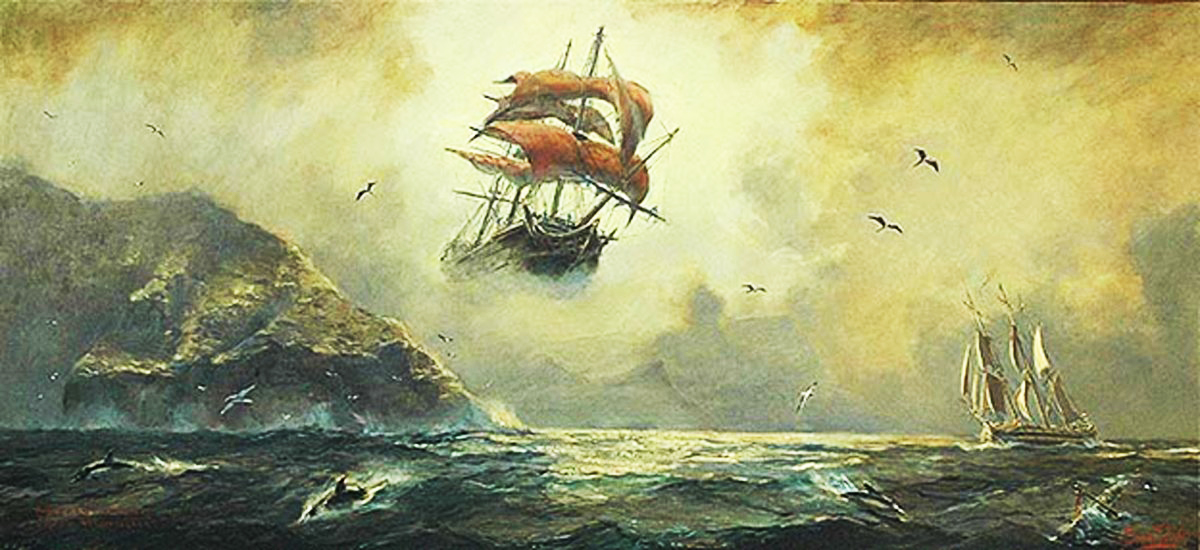
The Old Salt’s Corner
“Tales of Legendary Ghost Ships”
Legend of The Flying Dutchman
The legend of the Flying Dutchman goes back to the late 18th century when sailors allegedly saw a ghost ship that foretold imminent doom or disaster. Reports of a spectral ship persisted for the next 250 years despite there being no definitive proof that the ghost ship exists.
The first written accounts of the Flying Dutchman date back to the late 1700s, although stories began to circulate near the Cape of Good Hope. Ships used this common route to go from Europe to Asia, and one ship in particular didn’t fare so well on the journey.
Captain Hendrick van der Decken, AKA The Dutchman, departed Amsterdam for the far East Indies and loaded his ship with spices, silks, and dyes to sell back in the Netherlands. After making some repairs to his vessel, van der Decken set about a return course to Amsterdam in 1641.
When his ship rounded the Cape of Good Hope, a storm suddenly came upon the intrepid crew. They begged their captain to reverse course, but he ordered them to keep moving into the gale. Some believe van der Decken was mad while others said he was drunk.
As he refused to turn his ship around, the vessel sank to the bottom of the ocean. From this came the story and curse of the Flying Dutchman.
Written literature in 1790 and 1795 tell of a ghost ship that appeared in stormy weather. However, it wasn’t until an opera in 1843 that the Flying Dutchman truly became a legend. Richard Wagner’s “The Flying Dutchman” opera states that the cursed Dutchman is eternally damned for flying through the storm. As such, van der Decken’s ship and crew now roam the seas as a ghost ship with an ethereal crew.
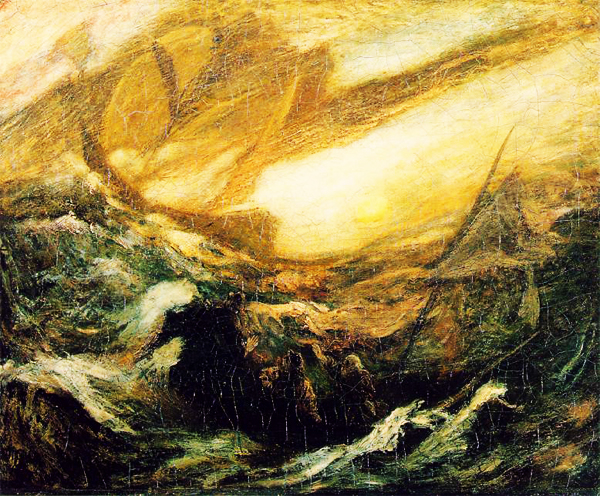
Another origin story points to Captain Bernard Fokke or Falkenberg who sailed for the Dutch East India Company. He was able to sail from Amsterdam to Indonesia in just three months, which led many sailors to speculate that he had traded his soul for amazing speed during a game of dice with the devil. That story served as imagery for Samuel Taylor Coleridge’s Rime of the Ancient Mariner in 1798.
The legend doesn’t stop with the musical story nor the Coleridge poem.
The most interesting written account of the Flying Dutchman comes from Prince George, the future King George V, on July 11, 1881. He and his older brother Prince Albert Victor were sailing near Australia as part of a three-year journey aboard the HMS Bacchante.
The crew reported the Flying Dutchman as it appeared in a glowing red light at 4 AM. When the Bacchante approached the spot where the ship was first seen, there was no trace of the vessel even though the night was clear. After the sighting, the crewman who first spotted the ghostly ship fell to his death off the topmast. This only gave credence to the legend in the eyes of the crew.
In 1939, residents of Cape Town, South Africa, claimed to see a vessel under full sail before it suddenly disappeared. During World War II, a German submarine crew supposedly saw a ghost ship in the Suez Canal. British writer Nicholas Monsarrat also spotted something akin to the Flying Dutchman during his time with the Royal Navy in World War II.
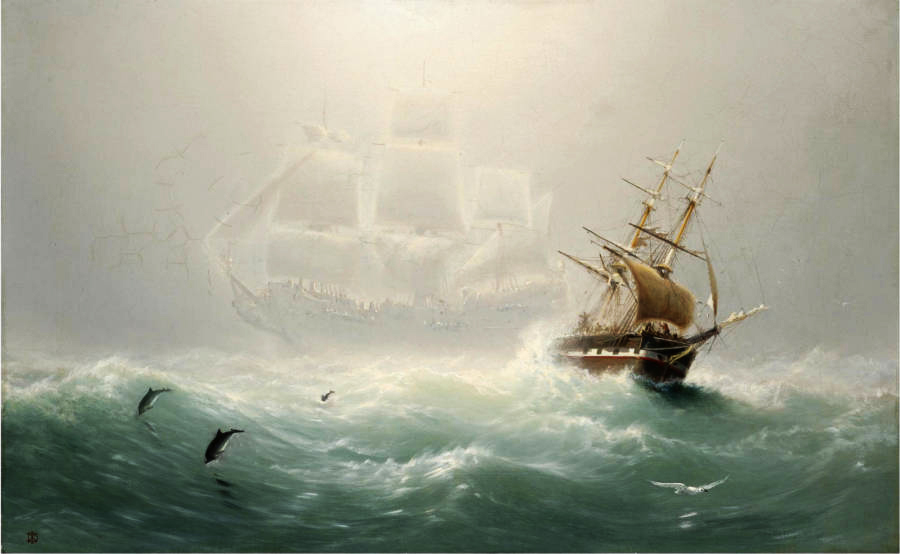
All of these sightings have a possible scientific explanation called fata morgana. This phenomenon occurs when light refracts and bend through different temperatures of air.
The surface of the ocean is the perfect medium for this anomaly to happen. This is especially true if someone sees a shimmery mirage along the horizon. Someone might also witness this along a hot asphalt road as heat waves rise from the surface. During this phenomenon, shapes form in the distance due to plays of light.
In terms of the Flying Dutchman, fata morgana shows ships that are actually beyond the horizon. That’s because light bends around the curve of the Earth in just the right way. By the time the sailors who witness the phenomenon get to the spot where they saw the ship, it’s gone.
This scientific phenomena obviously played tricks on the minds of sailors. Perhaps they thought they were seeing double or witnessing a ghostly, ethereal form.
The fact that ghostly apparitions at sea purportedly caused sailors to go bonkers and then die is a pure coincidence. Perhaps the bad luck or sudden deaths were psychosomatic. In other words, sailors died upon seeing something they couldn’t explain.
How cruelly ironic. If sailors had just kept their wits about them, they would still be alive. But then there would be no legend of the Flying Dutchman. Plus, Pirates of the Caribbean would need different plot points.
All That's Interesting

“I’m Just Sayin”
“It's what you learn after you know it all that counts.”
“It's not so important who starts the game,
but who finishes it.”
“Be more concerned with your character than your reputation,
because your character is what you really are,
while your reputation is merely what others think you are.”
~ John Wooden

“Thought for the Day”
“I would rather be politically dead than hypocritically immortalized.”
“We must not permit our respect for the dead or our sympathy for the living to lead us into an act of injustice to the balance of the living.”
“I would rather be beaten,
and be a man,
than to be elected and be a little puppy dog.”
~ Davy Crockett

“What I Learned”
“An advantage of being rich is that all your faults are called eccentricities.”
~ Anonymous

Second Hand News: Articles from Week 44 - October 26, 2020 - November 01, 2020
 The big Trump rallies you don't see
• Senate votes to advance Amy Coney Barrett nomination to Supreme Court
• Hunter Biden messages 'independently confirmed' to be authentic, Republican lawmaker says
The big Trump rallies you don't see
• Senate votes to advance Amy Coney Barrett nomination to Supreme Court
• Hunter Biden messages 'independently confirmed' to be authentic, Republican lawmaker says
Pelosi: Trump “delusional” if he thinks Republicans can win the House
• Joe Biden and Kamala Harris accuse Trump of admitting defeat after top aide says virus is uncontrollable
• Hot mic catches Kamala Harris asking what city she's in before addressing crowd
• Lincoln Project brushes off defamation lawsuit threat from Ivanka Trump and Jared Kushner
Afghanistan claims killing an al Qaeda leader wanted by FBI
• Chinese Communist Party are “assembling dossiers” on millions of foreign citizens to manipulate people in Western countries, senior U.S. official
• Harvest time and the return of college students spread the coronavirus to rural America
MOST READ: Multiple videos and images purportedly showing Hunter Biden engaging in sexual acts with several women and using drugs were uploaded on a Chinese website
• “Why don't you want to report this?:” RNC spokeswoman spars with CNN anchor over claim Hunter Biden emails are 'Russia disinformation'
• “What happened to you?:” Liberals slam Megyn Kelly for tweet saying Trump won final debate
Washington Examiner
 Lesley Stahl Is Wrong And Trump Is Right: The Obama Administration Spied On The Trump Campaign?
• Joe Biden Confuses Donald Trump With George W. Bush
• All Signs Point To One Thing: We’re Reliving The 2016 Election
Lesley Stahl Is Wrong And Trump Is Right: The Obama Administration Spied On The Trump Campaign?
• Joe Biden Confuses Donald Trump With George W. Bush
• All Signs Point To One Thing: We’re Reliving The 2016 Election
• Big Tech Is Turning The United States Into A Giant Company Town
New Data Shows Climate Change Hysteria Isn’t Grounded In Science
• SEVEN Open Leftist Threats That Political Terror Is Coming To America Whether Trump Wins Or Not
MOST READ: Joe Biden Says Democrats Created ‘The Most Extensive And Inclusive Voter Fraud Organization’ In American History
• California Just Declared War On Thanksgiving With Kafka-Level Regulations
• The Democrat Party Is Destroying America
• Trump Resistance Plans ‘Mass Mobilization’ After Election To Shut Down The Country If Biden Doesn’t Win
‘Don’t Mention Joe Being Involved’: Bombshell Texts Show Effort To Hide Joe Biden’s Involvement In Hunter’s Business Deals
• Of Course New York City Is A Ghost Town
• Music Publicist Says She Was Fired By Email For Attending Trump Rally
• CNN's Chris Cuomo: Get In The Closet, Serious Christians, Your Kind Aren’t Welcome In Public Life
The Federalist
 CORRUPTION CHRONICLES: New Fauci Emails On China, World Health Organization (WHO)
• Judicial Watch: Fauci Emails Show WHO Entity Pushing for a Press Release ‘Especially’ Supporting China’s Response to the Coronavirus
CORRUPTION CHRONICLES: New Fauci Emails On China, World Health Organization (WHO)
• Judicial Watch: Fauci Emails Show WHO Entity Pushing for a Press Release ‘Especially’ Supporting China’s Response to the Coronavirus
“Investigating the Investigators:” Judicial Watch Statement on Ninth Circuit Decision Regarding 78-Year-Old Veteran Prosecuted for Allegedly Taking Photos of American Flags at Veterans Affairs Facility on Memorial Day
Judicial Watch Sues for McCabe/Strzok/Page FBI Text Messages
Judicial Watch Asks Court to Order Release of Bodycam Footage in Fatal Police Shooting of Duncan Lemp During ‘No-Knock’ Raid
Judicial Watch
FAKE NEWS CBS Protects Biden from Scrutiny: Hunter Emails Are 'Russian Disinformation', Right?
• Biden Ad Misleads, But Snopes Attacks Conservative Media for Exposing It!
FAKE NEWS: New York Times Hails Communist Angela Davis as Criminal Justice Reformer
• MSDNC's Ali Velshi Loves Jim Clyburn's Claim that Trump Could Return the U.S. to the Reconstruction Era
Senator Tom Cotton Slam Dunks CNBC Journalist Over Suppression of Hunter Biden Laptop Story
• New York Mayor Bill De Blasio: ‘We Have To Think About’ Packing The Supreme Court If ACB Confirmed
• ABC Upset Rapper Detained After Gun Brandished at Trump Supporters

Debate analysis: The unanswered allegations against the Biden family.
 Debate analysis: The better moderator still interrupts The President
Debate analysis: The better moderator still interrupts The President
 Debate analysis: Biden spreads gloom and skirts China.
Debate analysis: Biden spreads gloom and skirts China.
 Debate Analysis How did Pennsylvania hear the debate?
Debate Analysis How did Pennsylvania hear the debate?
 Debate analysis The Sturm Ruger Metric
Debate analysis The Sturm Ruger Metric
 Debate Analysis by @ConradMBlack
Debate Analysis by @ConradMBlack

The final presidential debate in Nashville, Tennessee
 2 of 6
2 of 6
 3 of 6
3 of 6
 4 of 6
4 of 6
 5 of 6
5 of 6
 6 of 6
6 of 6

No evidence of Russian disinformation in the Hunter Biden laptop and hard drive.
 More questions on the Hunter Biden-China Connection 2011-2013.
More questions on the Hunter Biden-China Connection 2011-2013.
 The timeline of Hunter Biden's water-damaged hard drive and rescued data, April 2019-0ctber 2020.
The timeline of Hunter Biden's water-damaged hard drive and rescued data, April 2019-0ctber 2020.
 John Batchelor (10/26/2020)
John Batchelor (10/26/2020)
 Mr. Answer Man Please Tell Us: The Chilling History of Halloween Traditions
Mr. Answer Man Please Tell Us: The Chilling History of Halloween Traditions
The original Halloween, dating back to ancient times, was a pagan celebration called Samhain (pronounced “sow-win”). The ancient Celts celebrated this holiday right around the end of October into early November (sound familiar?) because it was halfway between the autumnal equinox and the winter solstice. The purpose of the celebration was to welcome the harvest season as well as the “dark half” of the year. Another component involved honoring deceased ancestors and providing offerings to departed spirits; the celebrants believed that the boundary between the worlds of the living and the dead was especially weak during this time.
As the influence of Catholicism spread, the Catholic church tweaked many pagan holidays like Samhain to make them religion-friendly. The Catholic All Saints’ Day, which remembers saints and martyrs, falls on November 1, and All Souls’ Day, which honors the faithful departed, is November 2—two holidays that have to do with death and the afterlife.
The night before All Saints’ Day was called All Hallow’s Eve (“hallow” meaning holy), which turned into “Halloween”. The history of halloween dates back centuries, and its origins aren’t all about collecting candy.

History of Halloween Tradition: Ghosts and Spirits
All Saints’ Day was actually originally celebrated in May but moved to November in the ninth century to incorporate the Celtic holiday of Samhain at the end of October. (celebrating the dead in autumn, when the leaves die and fall from the trees.)
Samhain, which marked the conclusion of the harvest season, was also the Celtic new year, the end of the summer and the beginning of the dark and deadly season of winter. At this time, the Celts believed, the veil between life and death was at its thinnest, and spirits may travel between the two worlds.
Trick-or-treating
During Samhain, the Celts offered food as a way to ward off evil spirits. In the Middle Ages on the eve of All Saints’ Day, the poor would go “souling”, visiting houses and offering prayers for the family’s dead in exchange for food, called “soul cakes”.
As Irish and Scottish immigrants brought Halloween traditions to America in the 19th century, the holiday began to be associated with mischievousness, and trick-or-treating became what one historian calls an “extortion deal”:
Give us treats, or we’ll play a prank on you.
As the vandalism became more serious, in the 1930s communities started encouraging trick-or-treating as we know it today in order to keep youngsters out of trouble.
Dressing in Costume
To protect themselves from the potentially evil spirits that may appear during Samhain, the Celts wore animal skin costumes to hide in plain sight.
If they looked like a fellow spirit, they believed, it would be safe to go outside. Later, a variant of souling called “guising” emerged in Scotland, in which children dressed up and asked neighbors for food or money in exchange for a song or poem. In nineteenth-century America, masked Halloween pranksters were harder to identify.
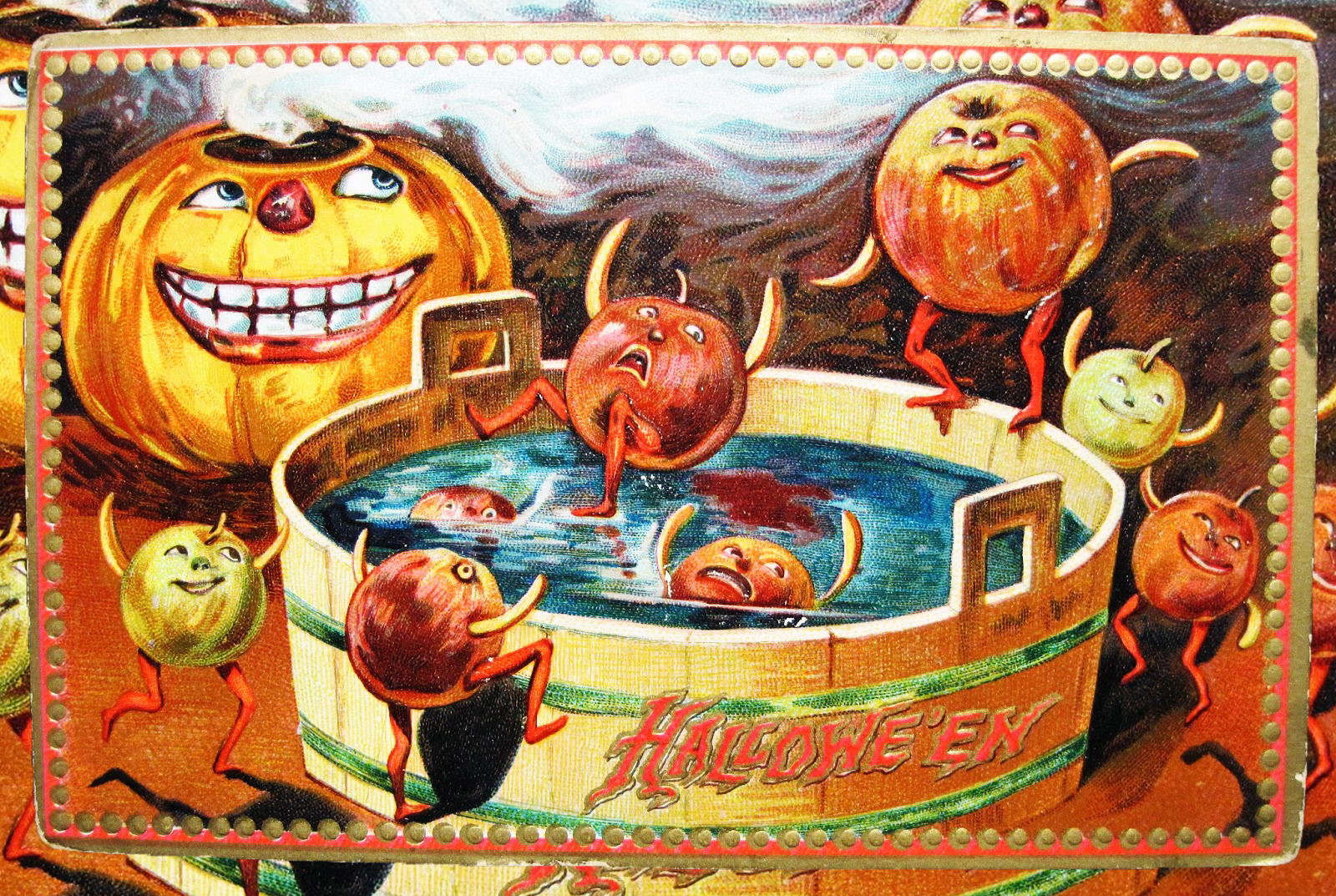
Eating Candy
In the early days of trick-or-treating, the goodies weren’t necessarily candy. After the end of sugar rationing in World War II, candy companies realized the money-making power of Halloween.
The baby boom was in full effect, and suburban neighborhoods perfect for trick-or-treating were growing. Small, affordable candies became the thing to give, especially as the 1970s and ’80s led rise to fears of the dangers of homemade or unwrapped sweets.
Mass-marketed, individually wrapped treats seemed the best way to keep kids safe.
Candy Corn
Although Halloween is associated with candy, most candy is not specifically associated with Halloween - except the ever-present candy corn.
The love-it-or-hate-it sweet, with its seasonal stripes of yellow, orange, and white, was actually originally meant to look like corn kernels for chicken feed.
The confection was created by candy maker George Renniger in Philadelphia and first sold in 1898. Although not initially marketed for Halloween, candy corn’s harvest theme made it a perfect fit as trick-or-treating became more prevalent.

Halloween Parties
Because of the popularity of trick-or-treating, Halloween is seen as a celebration for kids today. But for those adults who still get into the spirit, you’re not alone:
Grown-up Halloween parties have been around since the holiday came to America before it became focused on the young. Based on the old Samhain feasts, these gatherings featured autumnal foods, like nuts and fruits, and party games. Activities associated with the spiritual, such as fortune-telling and ghost stories, were also often part of the fun.
Bobbing for Apples
One of the most time-honored Halloween party games centered around the classic fruit of harvest time, the apple, a symbol of fertility that features in many fortune-telling activities.
One variation of bobbing for apples purports that whoever can grab the apple with their teeth will marry first; other versions have the apples marked with initials, indicating a successful bobbers’ future mate.
The apple tradition may also have some roots in the Roman harvest festival celebrating Pomona, the goddess of fruit and orchards.

Carving Pumpkins
Today’s jack-o-lanterns tend to lean towards comical, when it comes to the history of Halloween traditions like this one, there’s a good mix of spooky in the story.
According to the original Irish legend, Stingy Jack tried to cheat the devil out of his soul. But when Jack died, heaven didn’t want him either, so the devil cursed him to roam the earth using a carved-out turnip as a lantern.
A tradition began of carving scary faces into turnips, beets, or potatoes and putting them in the window to scare away “Jack of the Lantern” and other spirits.
It may be decorative gourd season today, but the first jack-o-lanterns were carved out of turnips.
When Halloween came to America, people figured out that pumpkins make even better jack-o-lanterns.
Readers Digest / Wikipedia / Encyclopedia Britannica /
Mental Floss / Quora /
Live Science / Boston University / Business Insider /
The Chilling History of Halloween Traditions (YouTube) 

NAVSPEAK aka U.S. Navy Slang
POD (Plan of the Day): An official document issued by a command that states all activities occurring that day, from 0000 to 2359. Also contains the Uniform of the Day. Also called the Possibilities of the Day or Plan of Deception because the plan can change without notice.
POG: (Person Other than Grunt): A term often used by Marine Infantry (Grunts) to refer to anyone who is not them. Specifically anyone in an Admin Field. Originally, “pogue”.
Pogey Bait: Candy, sweets, ice cream, etc., so called because such items are used as “bribes” for a pogue.
Pogue: A homosexual who may be called a “twink”, usually under-aged. This term may be used pejoratively (see Pogey bait), as no one but Marines are interested in pogues or baiting homosexuals.
Polish a Turd: Make the most of a bad situation e.g. Karlene Golding wearing make-up.
Pollywog: An individual who has not crossed the Equator, who must go through rituals, that sometimes cross the line to be hazing, to become a shellback. This practice can be traced back hundreds of years and is conducted in many countries' Navies across the globe. See crossing the line.
Wiktionary.org

Just for you MARINE
Pizza Box: The Marksman Weapons Qualification Badge, so named for its square shape.
Pizza Stain: A nickname used by some Marines during recruit training to refer to the National Defense Service Medal, so named for the red and yellow appearance, like the cheese and sauce of a pizza.
Platoon Sergeant: Staff Non-Commissioned Officer (SNCO) executive to the platoon commander, usually the senior enlisted man.
PMCM: Equipment such as aircraft that are partially mission capable due to maintenance that needs to be performed. Parts are available but not manpower.
PMCS: Preventive Maintenance Checks and Services, regularly performed maintenance on equipment, as opposed to corrective maintenance. Also, partial mission capability of equipment such as aircraft due to parts shortage in the supply chain.
PMO: Provost Marshal's Office, the military police force of a Marine installation.
P.O.A.: Position Of Attention.
Pogue: Marine not of the combat arms (infantry), etymology is disputed: possibly “pogue” derived from the Tagalog word meaning “prostitute” or the Erse Gaelic word meaning “to kiss [my ass]”, while “POG” could be from the acronym Persons Other than Grunt, but could be a backronym.
Poguey or Pogey Bait: Candy or sweets. See also geedunk.
Poguey or Pogey Rope: The French Fourragère authorized for wear by members of the 5th and 6th Marine Regiments.
Police: To pick up items (such as litter or expended ammunition casings), to return an area to a natural state, or to correct another Marine.
Wikipedia.org

Naval Aviation Squadron Nicknames
Navy Rotary Wing Weapons School Naval Aviation Warfighting Development Center (NAWDC, pronounced NAW-DIK) - nicknamed the “Outrider”
United States Navy Pacific Missile Range Facility), Barking Sands, Kauai County, near Kekaha, Hawaii, U.S.: The U.S. Army acquired the land in 1940, named it Mana Airport; The U.S. Navy operations at Bonham began in 1956; In 1964, the Pacific Missile Range Facility and Bonham was transferred to the U.S. Navy, becoming Pacific Missile Range Facility, Barking Sands - present.

Where Did That Saying Come From?
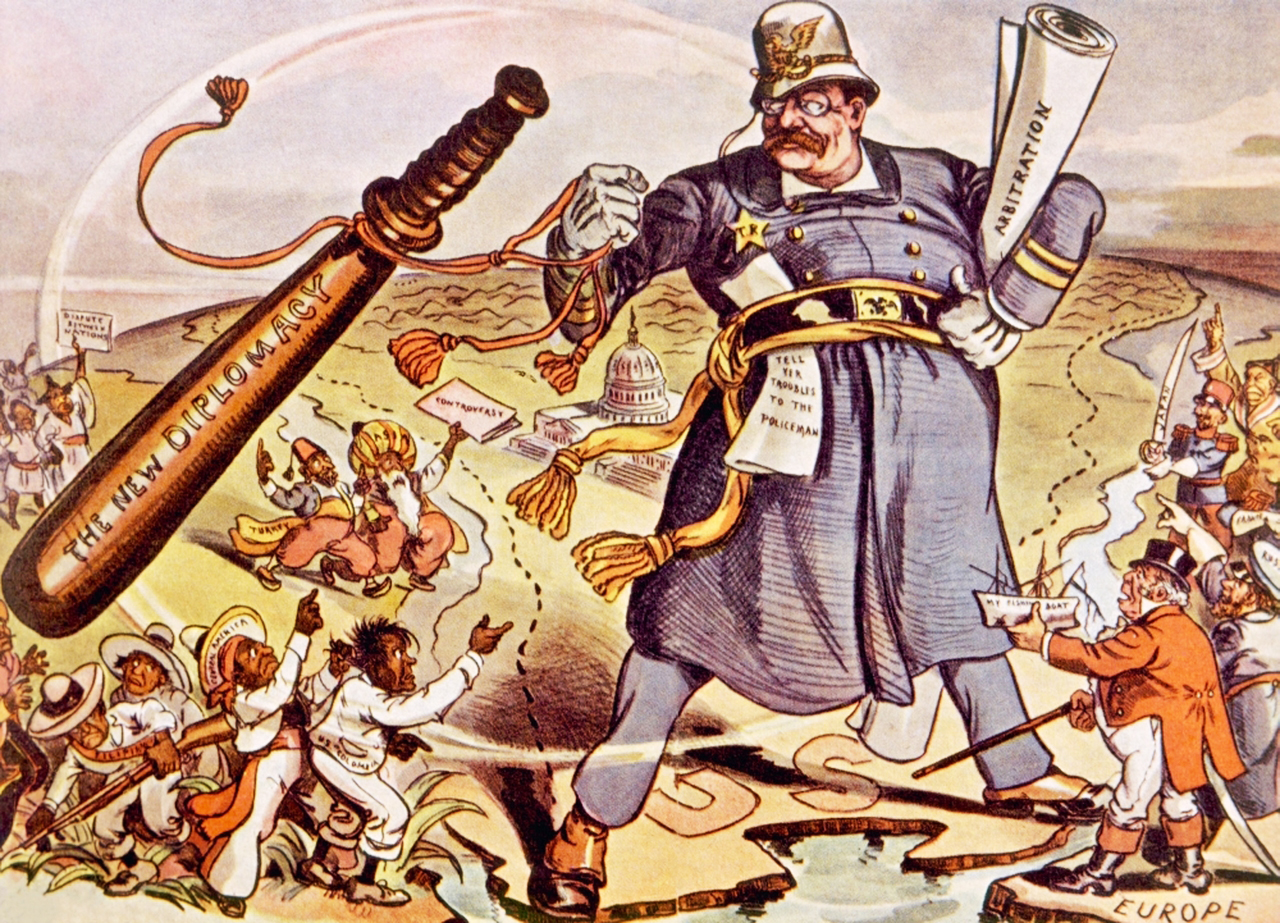
“Speak softly and carry a big stick:”
Meaning: 'Speak softly and carry a big stick' is a proverbial saying advising the tactic of caution and non-aggression, backed up by the ability to carry out violent action if required.
History: The notion being expressed here is the opposite of the tactics employed by every temporary schoolteacher - who begin stern and tough and, when discipline allows it, become more easy-going. The 'speak softly...' doctrine, like the earlier phrase 'the iron fist in the velvet glove', was to begin gently, but hold a decisive weapon in reserve.
The widespread use of 'speak softly and carry a big stick' began with American president Theodore Roosevelt. In a letter to Henry L. Sprague, on January 26th 1900, he wrote:
“Speak softly and carry a big stick; you will go far.”

In that letter Roosevelt claims the phrase to be of West African origin, but I can find no corroborative evidence for that assertion. If it truly was proverbial in 1900 it ought to be easy to find earlier citations of it, but I can find none. Nor is there any known record of the phrase actually being used in West Africa before Roosevelt's time. Whether Roosevelt actually believed, for whatever reason, that the expression was West African, or whether he knew that it wasn't and was indulging in a form of 'Confucius he say' hokum in order to impart a degree of distinction to it, we don't know. It is certainly possible that he coined the phrase himself.
Phrases.org UK

Science & Technology

Making puffer fish toxin in a flask
• Chlamydia-related bacteria discovered deep below the Arctic Ocean
• Novel method for easier scaling of quantum devices
• Geneticists pump the brakes on DNA, revealing key developmental process
• Study finds signal cascade that keeps plant stem cells active
Phys.org / MedicalXpress / TechXplore
Inside Elon Musk’s plan to build one Starship a week - and settle Mars
• Rocket Report: Psyched up for Falcon Heavy, another SLS launch delay
• Proposed U.S. law is “Trojan horse” to stop online encryption, critics say
• 5 years of Intel CPUs and chipsets have a concerning flaw that’s unfixable
• A woman travels back in time to the 1800s to solve a mystery in Antebellum
ARS Technica

Bizarre News (we couldn’t make up stuff this good - real news story)
Ancient shell shows days were half-hour shorter 70 million years ago
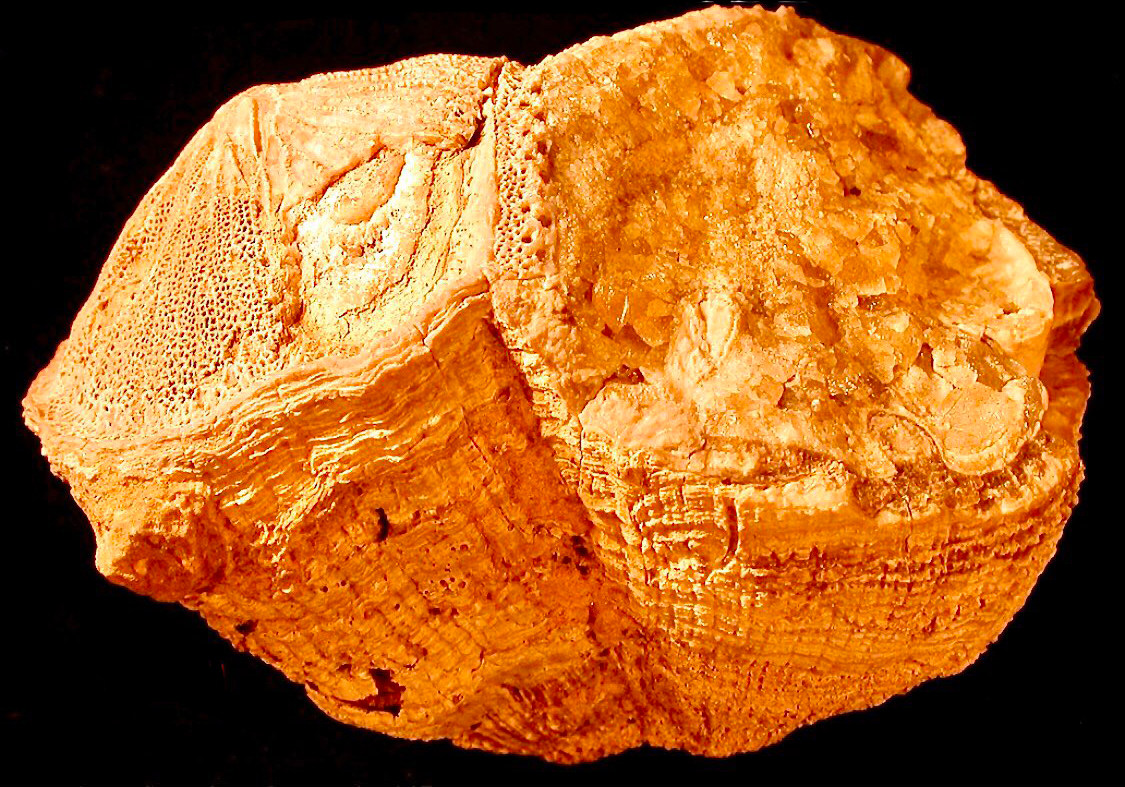
Source: American Geophysical Union
Summary: Earth turned faster at the end of the time of the dinosaurs than it does today, rotating 372 times a year, compared to the current 365, according to a new study of fossil mollusk shells from the late Cretaceous. The new measurement informs models of how the Moon formed and how close to Earth it has been over the 4.5-billion-year history of the Earth-Moon gravitational dance.
The ancient mollusk, from an extinct and wildly diverse group known as rudist clams, grew fast, laying down daily growth rings. The new study used lasers to sample minute slices of shell and count the growth rings more accurately than human researchers with microscopes.
The growth rings allowed the researchers to determine the number of days in a year and more accurately calculate the length of a day 70 million years ago. The new measurement informs models of how the Moon formed and how close to Earth it has been over the 4.5-billion-year history of the Earth-Moon gravitational dance.
The new study also found corroborating evidence that the mollusks harbored photosynthetic symbionts that may have fueled reef-building on the scale of modern-day corals.
The high resolution obtained in the new study combined with the fast growth rate of the ancient bivalves revealed unprecedented detail about how the animal lived and the water conditions it grew in, down to a fraction of a day.
“We have about four to five datapoints per day, and this is something that you almost never get in geological history. We can basically look at a day 70 million years ago. It's pretty amazing”, said Niels de Winter, an analytical geochemist at Vrije Universiteit Brussel and the lead author of the new study.
Climate reconstructions of the deep past typically describe long term changes that occur on the scale of tens of thousands of years. Studies like this one give a glimpse of change on the timescale of living things and have the potential to bridge the gap between climate and weather models.
Chemical analysis of the shell indicates ocean temperatures were warmer in the Late Cretaceous than previously appreciated, reaching 40 degrees Celsius (104 degrees Fahrenheit) in summer and exceeding 30 degrees Celsius (86 degrees Fahrenheit) in winter. The summer high temperatures likely approached the physiological limits for mollusks, de Winter said.
“The high fidelity of this data-set has allowed the authors to draw two particularly interesting inferences that help to sharpen our understanding of both Cretaceous astrochronology and rudist palaeobiology”, said Peter Skelton, a retired lecturer of palaeobiology at The Open University and a rudist expert unaffiliated with the new study.

Ancient reef-builders
The new study analyzed a single individual that lived for over nine years in a shallow seabed in the tropics - a location which is now, 70-million-years later, dry land in the mountains of Oman.
Torreites sanchezi mollusks look like tall pint glasses with lids shaped like bear claw pastries. The ancient mollusks had two shells, or valves, that met in a hinge, like asymmetrical clams, and grew in dense reefs, like modern oysters. They thrived in water several degrees warmer worldwide than modern oceans.
In the late Cretaceous, rudists like T. sanchezi dominated the reef-building niche in tropical waters around the world, filling the role held by corals today. They disappeared in the same event that killed the non-avian dinosaurs 66 million years ago.
“Rudists are quite special bivalves. There's nothing like it living today”, de Winter said. “In the late Cretaceous especially, worldwide most of the reef builders are these bivalves. So they really took on the ecosystem building role that the corals have nowadays.”
The new method focused a laser on small bits of shell, making holes 10 micrometers in diameter, or about as wide as a red blood cell. Trace elements in these tiny samples reveal information about the temperature and chemistry of the water at the time the shell formed. The analysis provided accurate measurements of the width and number of daily growth rings as well as seasonal patterns. The researchers used seasonal variations in the fossilized shell to identify years.
The new study found the composition of the shell changed more over the course of a day than over seasons, or with the cycles of ocean tides. The fine-scale resolution of the daily layers shows the shell grew much faster during the day than at night
“This bivalve had a very strong dependence on this daily cycle, which suggests that it had photosymbionts”, de Winter said.“You have the day-night rhythm of the light being recorded in the shell.”
This result suggests daylight was more important to the lifestyle of the ancient mollusk than might be expected if it fed itself primarily by filtering food from the water, like modern day clams and oysters, according to the authors. De Winter said the mollusks likely had a relationship with an indwelling symbiotic species that fed on sunlight, similar to living giant clams, which harbor symbiotic algae.
“Until now, all published arguments for photosymbiosis in rudists have been essentially speculative, based on merely suggestive morphological traits, and in some cases were demonstrably erroneous. This paper is the first to provide convincing evidence in favor of the hypothesis”, Skelton said, but cautioned that the new study's conclusion was specific to Torreites and could not be generalized to other rudists.

Moon retreat
De Winter's careful count of the number of daily layers found 372 for each yearly interval. This was not a surprise, because scientists know days were shorter in the past. The result is, however, the most accurate now available for the late Cretaceous, and has a surprising application to modeling the evolution of the Earth-Moon system.
The length of a year has been constant over Earth's history, because Earth's orbit around the Sun does not change. But the number of days within a year has been shortening over time because days have been growing longer. The length of a day has been growing steadily longer as friction from ocean tides, caused by the Moon's gravity, slows Earth's rotation./p>
The pull of the tides accelerates the Moon a little in its orbit, so as Earth's spin slows, the Moon moves farther away. The moon is pulling away from Earth at 3.82 centimeters (1.5 inches) per year. Precise laser measurements of distance to the Moon from Earth have demonstrated this increasing distance since the Apollo program left helpful reflectors on the Moon's surface.
But scientists conclude the Moon could not have been receding at this rate throughout its history, because projecting its progress linearly back in time would put the Moon inside the Earth only 1.4 billion years ago. Scientists know from other evidence that the Moon has been with us much longer, most likely coalescing in the wake of a massive collision early in Earth's history, over 4.5 billion years ago. So the Moon's rate of retreat has changed over time, and information from the past, like a year in the life of an ancient clam, helps researchers reconstruct that history and model of the formation of the moon.
Because in the history of the Moon, 70 million years is a blink in time, de Winter and his colleagues hope to apply their new method to older fossils and catch snapshots of days even deeper in time.
Science Daily (03/09/2020) 

Second Hand News: Articles from Week 44 - October 26, 2020 - November 01, 2020
 Jill Biden has to whisper “Trump” under her breath after “Sleepy” Joe tells virtual rally: “We need to stop four more years of George” (but did he mean Bush Senior or Junior?)
• Joe Biden tells 60 Minutes it's Trump who's “round the bend” not him, says the Hunter scandal was caused by the Russians and laughs off concerns about his mental capacity
• “I'm running against Donald, not his children:” Biden calls the President “crass” for “going after Hunter”
• Alleged Hunter Biden sex tapes are uploaded on Chinese video site
Jill Biden has to whisper “Trump” under her breath after “Sleepy” Joe tells virtual rally: “We need to stop four more years of George” (but did he mean Bush Senior or Junior?)
• Joe Biden tells 60 Minutes it's Trump who's “round the bend” not him, says the Hunter scandal was caused by the Russians and laughs off concerns about his mental capacity
• “I'm running against Donald, not his children:” Biden calls the President “crass” for “going after Hunter”
• Alleged Hunter Biden sex tapes are uploaded on Chinese video site
“If Joe isn't the ‘Big Guy’ in Hunter's emails, why won't he say?” Republican Rep. Jim Jordan questions Biden's response to the scandal and says his office has confirmed everything on the laptop is real
• Biden concerns Pennsylvania voters with his “CONFUSING” message over fracking: Former VP gives three interviews and insists he won't ban fracking but will “transition” away from it - as AOC says it's “a good first step”
• Nancy Pelosi, 80, says she will run for House Speaker AGAIN if the Democrats win the majority after the election - despite calls from AOC to have her replaced
An hysterical rapper Cardi B screamed at cops to release her “unarmed” husband Offset after he was cuffed for “waving guns at people” from his car at a Trump rally with her cousin - who's been bailed on weapons charges
• AOC claims long lines at New York polling stations are 'voter suppression' as she is forced to wait two hours with her boyfriend and dog to cast her ballot in the Bronx
Donald Trump tells fans Hillary has more energy and is 'a much more intelligent person' than Biden - but insist they are both 'corrupt'
• Hillary Clinton says the thought of Trump winning re-election makes her “physically sick” and claims “most Republicans want to see him gone but can't say it publicly”
• NYPD cop is suspended without pay for yelling “Trump 2020” through his patrol car loudspeaker in Brooklyn after residents called him “racist” and de Blasio called it “unacceptable”
British special forces retake 42,000-ton oil tanker off UK coast in just SEVEN MINUTES as 16 commandos storm it from air and sea to detain seven 'Nigerian stowaways' who 'threatened to kill crew'
• Afghan security forces kill al Qaeda's second in command Abu Muhsin al-Masri, two years after he was listed as one of the world's most wanted terrorists
• MAGA supporter pulls a gun at anti-Trump protesters who 'dumped a bucket of brown liquid on him' during a rally in Washington state
Daily Mail
 Rioters Attack ‘Jews For Trump’ Convoy In New York City, Pelt Cars With Objects
• Bitter Hillary: Most Republicans ‘Cowards, Spineless Enablers’; ‘Literally Sick To My Stomach’ Thinking Of Trump Win
Rioters Attack ‘Jews For Trump’ Convoy In New York City, Pelt Cars With Objects
• Bitter Hillary: Most Republicans ‘Cowards, Spineless Enablers’; ‘Literally Sick To My Stomach’ Thinking Of Trump Win
Three Nuns Stand Right Behind Trump At Rally Wearing MAGA Masks
• Social Media Erupts Over Woman Who Focuses On Getting Her Dad To Vote For Biden While He Is Dying
Biden Snaps At Reporter For Bringing Up Hunter Biden Controversy: ‘It’s All A Lie’
• Biden: ‘This Is The Most Consequential Election’ Due To Possibility Of ‘Four More Years Of George’
‘60 Minutes’ Host Tells Harris She Is The Most Far-Left Member Of U.S. Senate. Harris Struggles To Respond.
• Biden Draws 130 Cars At Rally, Obama Doesn’t Fare Much Better
Pelosi Says She Wants To Be Speaker Again If Democrats Control House
• ‘Toy of Genocide:’ Disney Under Pressure to Remove Woody from Toy Story for Crimes Against Native Americans
Daily Wire


SONG FACTS

“I Love You”  - The Zombies
- The Zombies
Album: Absolutely the Best
Released 1965
I Love You:”  This plaintive or melancholy song is about a guy who knows the right words, but can't say them to the object of his affection, as he is rendered mute every time he tries.
This plaintive or melancholy song is about a guy who knows the right words, but can't say them to the object of his affection, as he is rendered mute every time he tries.
33 repetitions of “I Love You” in this song:
21 in the chorus sections, 9 in the outro, and 3 in the verses; the song even begins and ends with the phrase. For a guy who can't utter the phrase to a girl, he sure can spout it when she's not listening!
I Love You”  was released in 1965 as the B-side to the single “Whenever You're Ready”
was released in 1965 as the B-side to the single “Whenever You're Ready”  . It was written by Zombies bassist Chris White, and recorded on July 8, 1965, at Decca Studios.
. It was written by Zombies bassist Chris White, and recorded on July 8, 1965, at Decca Studios.
White, when interviewed about this song, said:
“The thing that came first was the riff. That was the root of writing that one. In actual fact I think I nicked it off Tommy Roe.”
While The Zombies version of this song was relegated to a B-side, it clearly deserved better, and got it when the song was recorded by a San Jose six-piece called People! (the exclamation point was part of their name), who recorded it as a demo in 1967. When Capitol Records heard their take on the song, they signed the group and had them make a proper recording of the song, which was issued in 1968 as their first single.
The Zombies broke up before their second album, Odessey and Oracle, was released. Post-mortem, the group finally got their due, with “Time Of The Season”  becoming a huge hit and the album hailed as a classic. As listeners discovered their back catalog, songs like this one found a new audience draw to the group's progressive sound featuring Rod Argent's organ work.
becoming a huge hit and the album hailed as a classic. As listeners discovered their back catalog, songs like this one found a new audience draw to the group's progressive sound featuring Rod Argent's organ work.
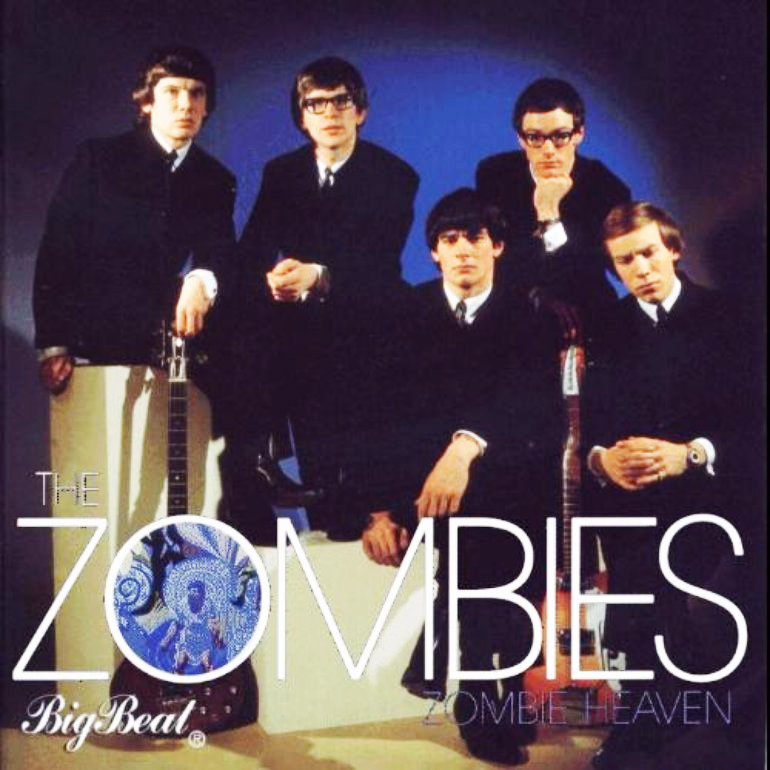
“I Want You Back Again”  - The Zombies
- The Zombies
Album: Zombie Heaven
Released 1965
I Want You Back Again”  Written by Zombies keyboard player Rod Argent, this song is about a guy who isn't handling a breakup very well - all he can think about is getting his girl back again.
Written by Zombies keyboard player Rod Argent, this song is about a guy who isn't handling a breakup very well - all he can think about is getting his girl back again.
Running a tight 1:58, it's an early Zombies track with the trademark elements of the band:
Colin Blunstone's breathy, desperate vocals and Argent's organ break.
The Zombies had a huge hit in 1964 with “She's Not There”, but very little ensuing output. Their first album emerged in 1965, and this song came out that same year as a standalone single in the U.S.. With management problems and burnout plaguing the band, it suffered from poor promotion and distribution, and barely cracked the Hot 100.
Many journalists, listeners and musicians consider this song a hidden gem. Perhaps the its biggest champion is Tom Petty, who saw The Zombies at his first concert, tracked down this song, and learned how to play it. Decades later, he started performing the song with his group Tom Petty and the Heartbreakers, playing it at a run of shows at The Fillmore in San Francisco in 1997, and including it from time to time in subsequent shows.

“Just Out Of Reach”  - The Zombies
- The Zombies
Album: Bunny Lake Is Missing
Released 1965
Just Out Of Reach”  is about a guy who is desperate to get his girl back, but he can't, since she's “just out of reach”.
is about a guy who is desperate to get his girl back, but he can't, since she's “just out of reach”.
Written by Zombies lead singer Colin Blunstone for the Otto Preminger film Bunny Lake Is Missing. The group was enlisted to write songs for the movie, where they appeared in scenes where the characters are watching them on television. The group's main songwriter, Rod Argent, was tapped out of ideas, however, so they only contributed three tracks, this one and two more written by bass player Chris White: “Nothing's Changed”  and “Remember You”
and “Remember You”  (the composer Paul Glass wrote the rest of the songs).
(the composer Paul Glass wrote the rest of the songs).
Just Out Of Reach”  was also released as a single, bubbling under on the U.S. Hot 100 at #113.
was also released as a single, bubbling under on the U.S. Hot 100 at #113.
In Songfacts' 2015 interview with Colin Blunstone, he said of this song:
“I can't say that's really about anything other than trying to meet a deadline. But it's a good fun song - I really enjoyed playing that. We still play it with this incarnation of the band. Not every night, but we do play it sometimes. We do that really well, as well.”
The Zombies official site / Rock & Roll Hall of Fame / Billboard / All Music / Song Facts / The Zombies
Image: “ The Zombies (album)” by The Zombies

Trivia
● What is the name of Dr. Evil's cat in the movie “Austin Powers”?
Answer to Trivia
● Who described his most famous painting as “the Camembert of time”?
Answer to Trivia
● What are pink dolphins commonly referred to as?
Answer to Trivia
● What large island lies about 300 miles due east of Mozambique?
Answer to Trivia

A Test for People Who Know Everything
From the Jeopardy Archives Category - “FRENCH OFF THE BOAT” ($200)
“In 1920 a ship brought this 10-year-old future ocean explorer & family from France to New York City for a 2-year stay.”
● Answer for People Who Do Not Know Everything, or Want to Verify Their Answer Famous Scientists.org
From the Jeopardy Archives Category - “FRENCH OFF THE BOAT” ($400)
“By 1809 this man & his brother Pierre had arrived in New Orleans & set up a blacksmith shop; piracy paid better, so...”
● Answer for People Who Do Not Know Everything, or Want to Verify Their Answer Battle Fields.org
From the Jeopardy Archives Category - “FRENCH OFF THE BOAT” ($600)
“A few years after sailing here on the American Eagle, Irenee Du Pont opened a gunpowder mill in this state.”
● Answer for People Who Do Not Know Everything, or Want to Verify Their Answer Hagley.org
From the Jeopardy Archives Category - “FRENCH OFF THE BOAT” ($800)
“This future city planner was only 22 when he arrived on the Amphitrite to serve as an engineer in the revolution.”
● Answer for People Who Do Not Know Everything, or Want to Verify Their Answer Smithsonian
From the Jeopardy Archives Category - “FRENCH OFF THE BOAT” ($1,000)
“The wreck of Captain Ribaut's flagship Trinité is still off Florida, a relic of France's first New World outpost at this fort.”
● Answer for People Who Do Not Know Everything, or Want to Verify Their Answer Ocean Explorer NOAA.gov
Answer to Last Week's Test
From the Jeopardy Archives Category - “STARTS OR ENDS WITH A BODY PART” ($200)
“To assist with the mail or with the birth of a baby.”
● Answer: Deliver. The Cut
From the Jeopardy Archives Category - “STARTS OR ENDS WITH A BODY PART” ($400)
'
“Diminutive term for a quick writing method done to take dictation.”
● Answer: Shorthand. Wikipedia
From the Jeopardy Archives Category - “STARTS OR ENDS WITH A BODY PART” ($600)
“Greaves were part of a knight's set of it.”
● Answer: Armor. Ancient History Encyclopedia.eu
From the Jeopardy Archives Category - “STARTS OR ENDS WITH A BODY PART” ($800)
“A spiky 'sea' creature.”
● Answer: an Urchin. Wikipedia
From the Jeopardy Archives Category - “STARTS OR ENDS WITH A BODY PART” ($1,000)
“It sounds like you might need a shovel at this rowdy, down-home type of party.”
● Answer: a Shindig (Dhruv: What is a hoedown?)...[The end-of-round signal sounds.] Triple Stumper. Ancient History Encyclopedia.eu

Joke of the Day

“Crowded City at a Crowded Bus Stop”
In a crowded city at a crowded bus stop, a stunningly beautiful young woman was waiting for the bus.
She was decked out in a tight black leather mini skirt with matching leather boots and jacket.
As the bus rolled up and it became her turn to get on the bus, she became aware that her skirt was too tight to allow her leg to come up to the height of the bus' first step.
So, slightly embarrassed and with a quick smile to the bus driver, she reached behind her and unzipped her skirt a little, thinking that this would give her enough slack to raise her leg.
Again she tried to make the step onto the bus only to discover she still could not make the step.
So, a little more embarrassed, she once again reached behind her and unzipped her skirt a little more.
And for a second time she attempted the step and once again, much to her dismay, she could not raise her leg because of the tight skirt.
So, with a coy little smile to the driver, she again unzipped the offending skirt to give a little more slack and again was unable to make the step.
About this time the big Texan that was behind her in the line - picked her up easily from the waist and placed her lightly on the step of the bus.
The pretty young woman went ballistic and turned on the would-be hero, yelling at him, “How dare you touch my body! I don't even know who you are!!!”
At this the Texan drawled, “Well ma'am, normally I would agree with you but after you unzipped my fly three times, I kind of figured that we were friends.”
















































